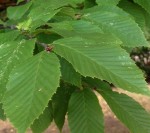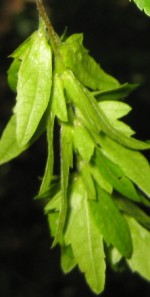 Also called musclewood, this small to medium sized deciduous tree is native to Eastern US from Maine to Florida, west to Minnesota and Texas where it grows as an understory tree in woods, along streams, and on river banks. It is a member of the birch family, Betulaceae, that also includes alders and hazels. The silver-gray trunk and mature branches are often fluted, twisted and sinuous so as to resemble muscles, accounting for the common name musclewood. The oval, leaves are doubly toothed, pointed, and two to four inches long They have a quilted appearance and are dark green turning mauve to orange in the fall. Separate pendulous catkins of small white female flowers and small greenish male flowers appear on the same tree in spring with the female flowers giving rise to clusters of nutlets with ragged wings in autumn. With its attractive oval shape American hornbeam is a good choice for a patio, specimen tree, or part of a woodland garden. The generic name Carpinus is the Latin name for the plants. The specific epithet caroliniana refers to North and South Carolina. The common name hornbeam is derived from the use of the wood for ox yokes.
Also called musclewood, this small to medium sized deciduous tree is native to Eastern US from Maine to Florida, west to Minnesota and Texas where it grows as an understory tree in woods, along streams, and on river banks. It is a member of the birch family, Betulaceae, that also includes alders and hazels. The silver-gray trunk and mature branches are often fluted, twisted and sinuous so as to resemble muscles, accounting for the common name musclewood. The oval, leaves are doubly toothed, pointed, and two to four inches long They have a quilted appearance and are dark green turning mauve to orange in the fall. Separate pendulous catkins of small white female flowers and small greenish male flowers appear on the same tree in spring with the female flowers giving rise to clusters of nutlets with ragged wings in autumn. With its attractive oval shape American hornbeam is a good choice for a patio, specimen tree, or part of a woodland garden. The generic name Carpinus is the Latin name for the plants. The specific epithet caroliniana refers to North and South Carolina. The common name hornbeam is derived from the use of the wood for ox yokes.
 Type: Small deciduous tree
Type: Small deciduous tree
Outstanding Feature: Form; fall color, sculptural trunk and branches ; shade tolerance
Form: Broadly oval to rounded crown
Growth Rate: Slow
Bloom: Separate pendulous catkins of small white female flowers and small greenish male flowers on the same tree in spring
Size: 15-35’ H x 20-35’ W
Light: Partial –full shade but may tolerate full sun.
Soil: Average, moderately moist, well-drained; tolerates soggy soil and moderate drought for short periods of time.
Hardiness: Zones 3-9
Care: Low maintenance
Pests and Diseases: Generally healthy but susceptible to cankers, leaf spot, twig blight
Propagation: Seed (stratified), cuttings (difficult)